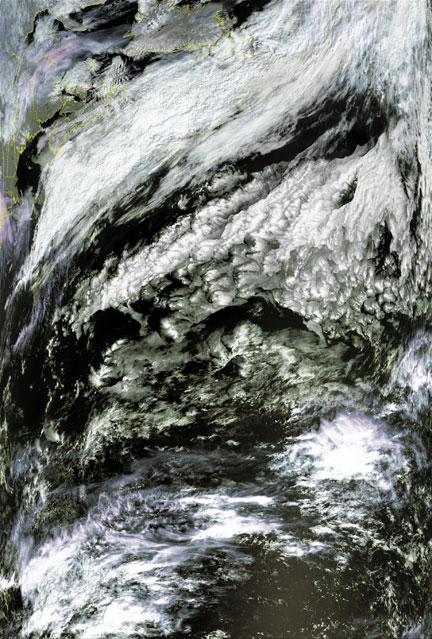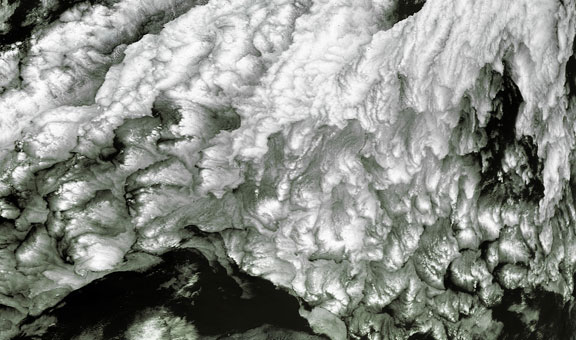| The image below shows the more extensive image from
which the picture at the far right below was taken. The clouds far out
into the Atlantic Ocean take on almost artistic patterns as the winds
blow them around. This is of course the manifestation of the non-linear
nature of, well, Nature.
 |
The early development of "chaos theory" (the popular name for
non-linear phenomena) was advanced greatly by the clouds that
Mitchell Feigenbaum observed in his early years of work at Los Alamos.
From the prologue of the book Chaos: Making a New Science by
James Gleick (http://www.around.com/chaos.html):
"Even Feigenbaum's friends were wondering whether he
was ever going to produce any work of his own. As willing as he was
to do impromptu magic with their questions, he did not seem
interested in devoting his own research to any problem that might
pay off. He thought about turbulence in liquids and gases. He
thought about time--did it glide smoothly forward or hop discretely
like a sequence of cosmic motion-picture frames? He thought about
the eye's ability to see consistent colors and forms in a universe
that physicists knew to be a shifting quantum kaleidoscope. He
thought about clouds, watching them from airplane windows (until, in
1975, his scientific travel privileges were officially suspended on
grounds of overuse) or from the hiking trails above the laboratory.
In the mountain towns of the West, clouds barely resemble the sooty
indeterminate low-flying hazes that fill the Eastern air. At Los
Alamos, in the lee of a great volcanic caldera, the clouds spill
across the sky, in random formation, yes, but also not-random,
standing in uniform spikes or rolling in regularly furrowed patterns
like brain matter. On a stormy afternoon, when the sky shimmers and
trembles with the electricity to come, the clouds stand out from
thirty miles away, filtering the light and reflecting it, until the
whole sky starts to seem like a spectacle staged as a subtle
reproach to physicists. Clouds represented a side of nature that the
mainstream of physics had passed by, a side that was at once fuzzy
and detailed, structured and unpredictable. Feigenbaum thought about
such things, quietly and unproductively. To a physicist, creating
laser fusion was a legitimate problem; puzzling out the spin and
color and flavor of small particles was a legitimate problem; dating
the origin of the universe was a legitimate problem. Understanding
clouds was a problem for a meteorologist. Like other physicists,
Feigenbaum used an understated, tough-guy vocabulary to rate such
problems. Such a thing is obvious, he might say, meaning that a
result could be understood by any skilled physicist after
appropriate contemplation and calculation. Not obvious described
work that commanded respect and Nobel prizes. For the hardest
problems, the problems that would not give way without long looks
into the universe's bowels, physicists reserved words like deep. In
1974, though few of his colleagues knew it, Feigenbaum was working
on a problem that was deep: chaos. "
What would you think if you saw the image below
with Feigenbaum's eyes??
Click
on the image below for a high-resolution (~200k) version.
 |
![]()